Title: Demonstration of quantum network protocols over a 14-km urban fiber link
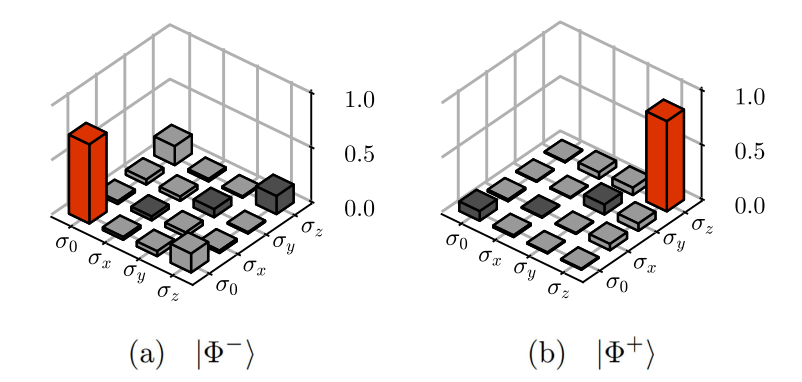 Authors: Stephan Kucera1,2, Christian Haen1, Elena Arenskötter1, Tobias Bauer1, Jonas Meiers1, Marlon Schäfer1, Ross Boland3, Milad Yahyapour3, Maurice Lessing3, Ronald Holzwarth3, Christoph Becher1, and Jürgen Eschner1
Authors: Stephan Kucera1,2, Christian Haen1, Elena Arenskötter1, Tobias Bauer1, Jonas Meiers1, Marlon Schäfer1, Ross Boland3, Milad Yahyapour3, Maurice Lessing3, Ronald Holzwarth3, Christoph Becher1, and Jürgen Eschner1
1Experimentalphysik, Universität des Saarlandes, Saarbrücken, Germany. 2Luxembourg Institute of Science and Technology (LIST), Belveaux, Luxembourg. 3Menlo Systems GmbH, Planegg, Germany.
Abstract
We report on the implementation of quantum entanglement distribution and quantum state teleportation over a 14.4 km urban dark-fiber link, which is partially underground, partially overhead, and patched in several stations. We characterize the link for its use as a quantum channel and realize its active polarization stabilization. Using a type-II cavity-enhanced SPDC photon pair source, a 40Ca+ single-ion quantum memory, and quantum frequency conversion to the telecom C-band, we demonstrate photon-photon entanglement, ion-photon entanglement, and teleportation of a qubit state from the ion onto a remote telecom photon, all realized over the urban fiber link.
Title: Designing noise-robust quantum networks coexisting in the classical fiber infrastructure
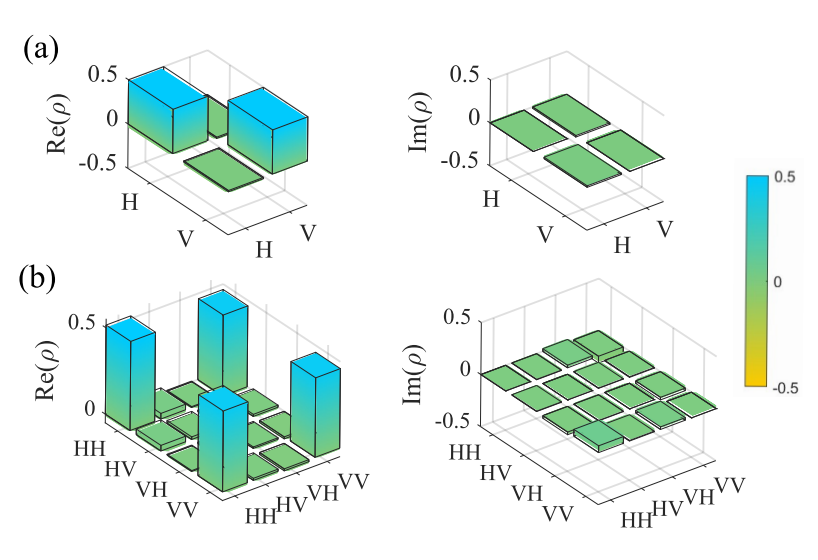 Authors: Jordan M. Thomas1, Gregory S. Kanter1,2, and Prem Kumar1,3
Authors: Jordan M. Thomas1, Gregory S. Kanter1,2, and Prem Kumar1,3
1Center for Photonic Communication and Computing, Department of Electrical and Computer Engineering, Northwestern University, 2145 N. Sheridan Rd., Evanston, IL 60208, USA. 2NuCrypt, LLC, 1460 Renaissance Dr #205, Park Ridge, IL 60068, USA. 3Department of Physics and Astronomy, Northwestern University, 2145 Sheridan Road, Evanston, IL 60208, USA.
Abstract
The scalability of quantum networking will benefit from quantum and classical communications coexisting in shared fibers, the main challenge being spontaneous Raman scattering noise. We investigate the coexistence of multi-channel O-band quantum and C-band classical communications. We characterize multiple narrowband entangled photon pair channels across 1282 nm-1318 nm co-propagating over 48 km of installed standard fiber with record C-band power (>18 dBm) and demonstrate that some quantum-classical wavelength combinations significantly outperform others. We analyze the Raman noise spectrum, optimal wavelength engineering, multi-photon pair emission in entangled photon-classical coexistence, and evaluate the implications for future quantum applications.
Title: Quantum receiver enhanced by adaptive learning
 Authors: Chaohan Cui1, William Horrocks1, Shuhong Hao2, Saikat Guha1,3, Nasser Peyghambarian1,2, Quntao Zhuang1,3,4, and Zheshen Zhang1,2,3,5
Authors: Chaohan Cui1, William Horrocks1, Shuhong Hao2, Saikat Guha1,3, Nasser Peyghambarian1,2, Quntao Zhuang1,3,4, and Zheshen Zhang1,2,3,5
1James C. Wyant College of Optical Sciences, University of Arizona, Tucson, AZ
85721, USA. 2Department of Materials Science and Engineering, University of
Arizona, Tucson, AZ 85721, USA. 3Department of Electrical and Computer
Engineering, University of Arizona, Tucson, AZ 85721, USA. 4Department of
Electrical and Computer Engineering, University of Southern California, Los
Angeles, CA 90089, USA. 5Department of Electrical Engineering and Computer
Science, University of Michigan, Ann Arbor, MI 48109, USA.
Abstract
Quantum receivers aim to effectively navigate the vast quantum-state space to endow quantum information processing capabilities unmatched by classical receivers. To date, only a handful of quantum receivers have been constructed to tackle the problem of discriminating coherent states. Quantum receivers designed by analytical approaches, however, are incapable of effectively adapting to diverse environmental conditions, resulting in their quickly diminishing performance as the operational complexities increase. Here, we present a general architecture, dubbed the quantum receiver enhanced by adaptive learning, to adapt quantum receiver structures to diverse operational conditions. The adaptively learned quantum receiver is experimentally implemented in a hardware platform with record-high efficiency. Combining the architecture and the experimental advances, the error rate is reduced up to 40% over the standard quantum limit in two coherent-state encoding schemes.
Title: Measurements of metastable helium in Earth’s atmosphere by resonance lidar
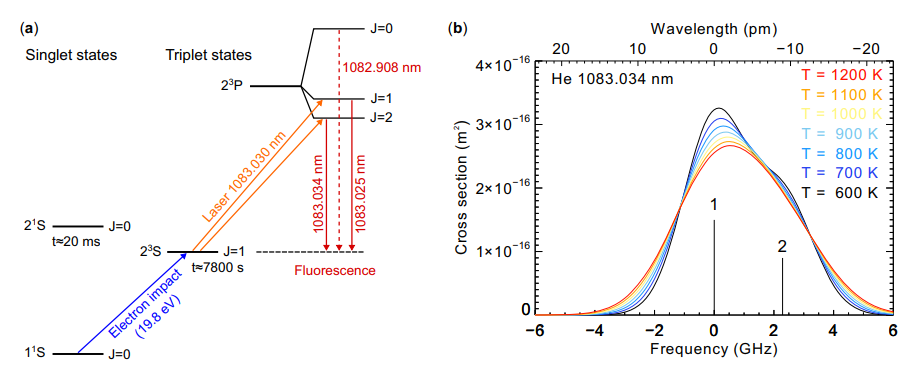 Authors: Bernd Kaifler1, Christopher Geach2, Hans Christian Büdenbender1
Authors: Bernd Kaifler1, Christopher Geach2, Hans Christian Büdenbender1
1Deutsches Zentrum für Luft- und Raumfahrt, Institut für Physik der Atmosphäre, Oberpfaffenhofen, Germany. 2Deutsches Zentrum für Luft- und Raumfahrt, Institut für Solar-Terrestrische Physik, Neustrelitz, Germany.
Abstract
Monitoring and predicting space weather activity is increasingly important given society’s growing reliance on space-based infrastructure but is hampered by a lack of observational data. Airglow at 1083 nm from metastable helium He(23S) in the thermosphere has long been a target for remote-sensing instruments seeking to fill that gap; however, passive measurements of He(23S) fluorescence are limited by low brightness, and interpretation of these observations is complicated by the > 500 km depth of the He(23S) layer. Here, we demonstrate a lidar instrument that is able to stimulate and detect He(23S) fluorescence, and we present measured profiles of He(23S) density. These measurements provide crucial validation to space weather models, support predictions of peak number density ( ~ 1 cm-3) and the dependence of density on altitude, solar zenith angle, and season, and extend by a factor of 4 the maximum probed altitude range by an atmospheric profiling lidar. These measurements open the door for the development of more sophisticated lidars: by applying well-established spectroscopic lidar techniques, one can measure the Doppler shift and broadening of the He(23S) line, thereby retrieving profiles of neutral wind speed and temperature, opening a window for studying space weather phenomena.
Title: Functional Time Domain Diffuse Correlation Spectroscopy
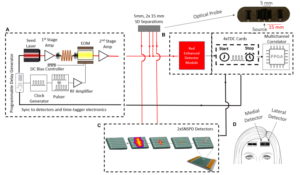 Authors: Nisan Ozana1, Niyom Lue2, Marco Renna1, Mitchell B Robinson1,3, Alyssa Martin1, Alexander I Zavriyev1, Bryce Carr1, Dibbyan Mazumder1, Megan H Blackwell2, Maria A Franceschini1, and Stefan A Carp1
Authors: Nisan Ozana1, Niyom Lue2, Marco Renna1, Mitchell B Robinson1,3, Alyssa Martin1, Alexander I Zavriyev1, Bryce Carr1, Dibbyan Mazumder1, Megan H Blackwell2, Maria A Franceschini1, and Stefan A Carp1
1Department of Radiology, Athinoula A. Martinos Center for Biomedical Imaging, Massachusetts General Hospital, Harvard Medical School, Boston, MA, United States.2Massachusetts Institute of Technology Lincoln Laboratory, Lexington, MA, United States.3Massachusetts Institute of Technology, Health Sciences and Technology Program, Cambridge, MA, United States.
Abstract
Time-domain diffuse correlation spectroscopy (TD-DCS) offers a novel approach to high-spatial resolution functional brain imaging based on the direct quantification of cerebral blood flow (CBF) changes in response to neural activity. However, the signal-to-noise ratio (SNR) offered by previous TD-DCS instruments remains a challenge to achieving the high temporal resolution needed to resolve perfusion changes during functional measurements. Here we present a next-generation optimized functional TD-DCS system that combines a custom 1,064 nm pulse-shaped, quasi transform-limited, amplified laser source with a high-resolution time-tagging system and superconducting nanowire single-photon detectors (SNSPDs). System characterization and optimization was conducted on homogenous and two-layer intralipid phantoms before performing functional CBF measurements in six human subjects. By acquiring CBF signals at over 5 Hz for a late gate start time of the temporal point spread function (TPSF) at 15 mm source-detector separation, we demonstrate for the first time the measurement of blood flow responses to breath-holding and functional tasks using TD-DCS.
Title: Superconducting nanowire single-photon sensing of cerebral blood flow
 Authors: Nisan Ozana1, Alexander I. Zavriyev1, Dibbyan Mazumder1, Mitchell Robinson1,2, Kutlu Kaya1, Megan Blackwell3, Stefan A. Carp1, and Maria Angela Franceschini1
Authors: Nisan Ozana1, Alexander I. Zavriyev1, Dibbyan Mazumder1, Mitchell Robinson1,2, Kutlu Kaya1, Megan Blackwell3, Stefan A. Carp1, and Maria Angela Franceschini1
1Massachusetts General Hospital, Harvard Medical School, Optics at Athinoula A. Martinos Center for Biomedical Imaging, Department of Radiology, Boston, Massachusetts, USA. 2Massachusetts Institute of Technology, Health Sciences and Technology Program, Cambridge, Massachusetts, USA. 3Massachusetts Institute of Technology Lincoln Laboratory, Lexington, Massachusetts, USA.
Abstract
Significance: The ability of diffuse correlation spectroscopy (DCS) to measure cerebral blood flow (CBF) in humans is hindered by the low signal-to-noise ratio (SNR) of the method. This limits the high acquisition rates needed to resolve dynamic flow changes and to optimally filter out large pulsatile oscillations and prevents the use of large source-detector separations (≥3 cm), which are needed to achieve adequate brain sensitivity in most adult subjects.
Aim: To substantially improve SNR, we have built a DCS device that operates at 1064 nm and uses superconducting nanowire single-photon detectors (SNSPD).
Approach: We compared the performances of the SNSPD-DCS in humans with respect to typical DCS system operating at 850 nm and using silicon single-photon avalanche diode detectors.
Results: At a 25-mm separation, we detected 13
Conclusions: While current commercial SNSPDs are expensive, bulky, and loud, they may allow for more robust measures of non-invasive cerebral perfusion in an intensive care setting.
Title: Noninvasive Optical Monitoring of Cerebral Blood Flow and EEG Spectral Responses after Severe Traumatic Brain Injury: A Case Report
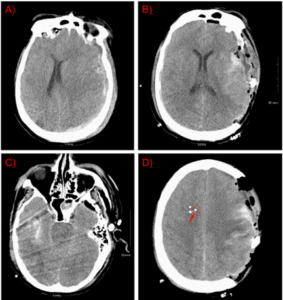 Authors: Chien-Sing Poon1, Benjamin Rinehart1, Dharminder S. Langri1, Timothy M. Rambo2, Aaron J. Miller2, Brandon Foreman3, and Ulas Sunar1
Authors: Chien-Sing Poon1, Benjamin Rinehart1, Dharminder S. Langri1, Timothy M. Rambo2, Aaron J. Miller2, Brandon Foreman3, and Ulas Sunar1
1Department of Biomedical Engineering, Wright State University, Dayton, OH 45435, USA. 2Quantum Opus, LLC, Novi, MI 48375, USA. 3Department of Neurology & Rehabilitation Medicine, University of Cincinnati, Cincinnati, OH 45267, USA.
Abstract
Survivors of severe brain injury may require care in a neurointensive care unit (neuro-ICU),
where the brain is vulnerable to secondary brain injury. Thus, there is a need for noninvasive, bedside, continuous cerebral blood flow monitoring approaches in the neuro-ICU. Our goal is to address this need through combined measurements of EEG and functional optical spectroscopy (EEG-Optical) instrumentation and analysis to provide a complementary fusion of data about brain activity and function. We utilized the diffuse correlation spectroscopy method for assessing cerebral blood flow at the neuro-ICU in a patient with traumatic brain injury. The present case demonstrates the feasibility of continuous recording of noninvasive cerebral blood flow transients that correlated well with the gold-standard invasive measurements and with the frequency content changes in the EEG data.
Title: Quantum computational advantage using photons
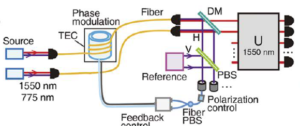
Authors: Han-Sen Zhong1,2, Hui Wang1,2, Yu-Hao Deng1,2, Ming-Cheng Chen1,2, Li-Chao Peng1,2, Yi-Han Luo1,2, Jian Qin1,2, Dian Wu1,2, Xing Ding1,2, Yi Hu1,2, Peng Hu3, Xiao-Yan Yang3, Wei-Jun Zhang3, Hao Li3, Yuxuan Li4, Xiao Jiang1,2, Lin Gan4, Guangwen Yang4, Lixing You3, Zhen Wang3, Li Li1,2, Nai-Le Liu1,2, Chao-Yang Lu1,2, Jian-Wei Pan1,2
1Hefei National Laboratory for Physical Sciences at Microscale and Department of Modern Physics, University of Science and Technology of China, Hefei, Anhui 230026, China. 2CAS Centre for Excellence and Synergetic Innovation Centre in Quantum Information and Quantum Physics, University of Science and Technology of China, Shanghai 201315, China. 3State Key Laboratory of Functional Materials for Informatics, Shanghai Institute of Microsystem and Information Technology, Chinese Academy of Sciences, Shanghai 200050, China. 4Department of Computer Science and Technology and Beijing National Research Center for Information Science and Technology, Tsinghua University, Beijing 100084, China.
Abstract
Quantum computers promise to perform certain tasks that are believed to be intractable to classical computers. Boson sampling is such a task and is considered a strong candidate to demonstrate the quantum computational advantage. We performed Gaussian boson sampling by sending 50 indistinguishable single-mode squeezed states into a 100-mode ultralow-loss interferometer with full connectivity and random matrix—the whole optical setup is phase-locked—and sampling the output using 100 high-efficiency single-photon detectors. The obtained samples were validated against plausible hypotheses exploiting thermal states, distinguishable photons, and uniform distribution. The photonic quantum computer, Jiuzhang, generates up to 76 output photon clicks, which yields an output state-space dimension of 1030 and a sampling rate that is faster than using the state-of-the-art simulation strategy and supercomputers by a factor of ~1014.
Title: Detector channel combining results from a high photon efficiency optical communications link test bed
 Authors: Jennifer N. Downey, Brian E. Vyhnalek, Sarah A. Tedder, and Nicholas C. Lantz
Authors: Jennifer N. Downey, Brian E. Vyhnalek, Sarah A. Tedder, and Nicholas C. Lantz
NASA Glenn Research Center 21000 Brookpark Road, Cleveland, Ohio 44135, USA.
Abstract
The National Aeronautics and Space Administration (NASA) Glenn Research Center (GRC) is developing a low cost, scalable, photon-counting receiver prototype for space-to-ground optical communications links. The receiver is being tested in a test bed that emulates photon-starved space-to-ground optical communication links. The receiver uses an array of single-pixel fiber coupled superconducting nanowire single-photon detectors. The receiver is designed to receive the high photon efficiency serially concatenated pulse position modulation (SCPPM) waveform specified in the Consultative Committee for Space Data Systems (CCSDS) Optical Communications Coding and Synchronization Blue Book Standard. The optical receiver consists of an array of single-pixel superconducting nanowire detectors, analog phase shifters for channel alignment, digitizers for each detector channel, and digital processing of the received signal. An overview of the test bed and arrayed receiver system is given. Simulation and system characterization results are presented. The data rate increase of using a four-channel arrayed detector system over using one single pixel nanowire detector is characterized. Results indicate that a single-pixel detector is capable of receiving data at a rate of 40 Mbps and a four-channel arrayed detector system is capable of receiving data at a rate of 130 Mbps.
Title: Generation of broadband correlated photon-pairs in short thin-film lithium-niobate waveguides
 Authors: Bradley S. Elkus1, Kamal Abdelsalam2, Ashutosh Rao2,3, Vesselin Velev1,4, Sasan Fathpour2, Prem Kumar1, Gregory S. Kanter1
Authors: Bradley S. Elkus1, Kamal Abdelsalam2, Ashutosh Rao2,3, Vesselin Velev1,4, Sasan Fathpour2, Prem Kumar1, Gregory S. Kanter1
1Department of Electrical and Computer Engineering, Center for Photonic Communication and Computing, Northwestern University, 2145 Sheridan Road, Evanston, Illinois 60208-3118, USA. 2CREOL, The College of Optics and Photonics, University of Central Florida, Orlando, Florida 32816, USA. 3Currently with the Microsystems and Nanotechnology Division, Physical Measurement Laboratory, National Institute of Standards and Technology, Gaithersburg, Maryland 20899, USA, and the University of Maryland, College Park, Maryland 20742, USA. 4Currently with Elenion Technologies, 171 Madison Ave #1100, New York, NY 10016, USA.
Abstract
An efficient source of quantum-correlated photon-pairs that is integrable with existing silicon-electronics fabrication techniques is desirable for use in quantum photonic integrated circuits. Here we demonstrate signal-idler photon pairs with high coincidence-to-accidental count ratios of over 103 on a coarse wavelength-division-multiplexing grid that spans 140 nm by using a 300-µm-long poled region in a thin-film periodically-poled lithium-niobate ridge waveguide bonded to silicon. The pairs are generated via spontaneous parametric downconversion pumped by a continuous-wave tunable laser source. The small mode area of the waveguide allows for efficient interaction in a short length of the waveguide and, as a result, permits photon-pair generation over a broad range of signal-idler wavelengths.
Title: Real Time Photon-Counting Receiver for High Photon Efficiency Optical Communications
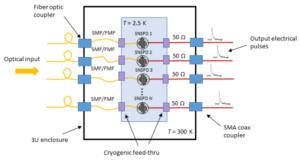 Authors: Jennifer N. Downey, Brian E. Vyhnalek, Sarah A. Tedder, and Nicholas C. Lantz
Authors: Jennifer N. Downey, Brian E. Vyhnalek, Sarah A. Tedder, and Nicholas C. Lantz
NASA Glenn Research Center 21000 Brookpark Road, Cleveland, Ohio 44135, USA.
Abstract
We present a scalable design for a photon-counting ground receiver based on superconducting nanowire single photon detectors (SNSPDs) and field programmable gate array (FPGA) real-time processing for applications to space-to-ground photon starved links, such as the Orion EM-2 Optical Communication Demonstration (O2O), and future deep space or low transmitter power missions. The receiver is designed to receive a serially concatenated pulse position modulation (SCPPM) waveform, which follows the Consultative Committee for Space Data Systems (CCSDS) Optical Communications Coding and Synchronization Red Book standard. The receiver design uses multiple individually fiber coupled, 80% detection efficiency commercial SNSPDs in parallel to scale to a required data rate, and is capable of achieving data rates up to 528 Mbps. For efficient fiber coupling from the telescope to the array of parallel detectors that can be scaled both to telescope aperture size and the number of detectors, we use either a single mode fiber (SMF) photonic lantern or a few-mode fiber (FMF) photonic lantern. In this paper we give an overview of the receiver system design, the characteristics of the photonic lanterns, the performance of the SNSPDs, and system level tests. We show that 40 Mbps can be received using a single SNSPD, and discuss aspects for scaling to higher data rates.
Title: Decay-Associated Fourier Spectroscopy: Visible to Shortwave Infrared Time-Resolved Photoluminescence Spectra

Authors: Timothy L. Atallah, Anthony V. Sica, Ashley J. Shin, Hannah C. Friedman, Justin R. Caram
Department of Chemistry and Biochemistry, University of California, Los Angeles, 607 Charles E. Young Drive, Los Angeles, California 90095-1569, USA
Abstract
We describe and implement an interferometric approach to decay associated photoluminescence spectroscopy, which we term decay associated Fourier spectroscopy (DAFS). In DAFS, the emitted photon stream from a substrate passes through a variable path length Mach-Zehnder interferometer prior to detection and timing. The interferometer encodes spectral information in the intensity measured at each detector enabling simultaneous spectral and temporal resolution. We detail several advantages of DAFS, including wavelength-range insensitivity, drift-noise cancellation, and optical mode retention. DAFS allows us to direct the photon stream into an optical fiber, enabling the implementation of superconducting nanowire single photon detectors for energy-resolved spectroscopy in the shortwave infrared spectral window (λ=1-2 μm). We demonstrate the broad applicability of DAFS, in both the visible and shortwave infrared, using two Förster resonance energy transfer pairs: a pair operating with conventional visible wavelengths and a pair showing concurrent acquisition in the visible and the shortwave infrared regime.
Title: Few-mode fiber coupled superconducting nanowire single-photon detectors for photon efficient optical communications

Authors: Brian E. Vyhnalek, Sarah A. Tedder, Evan J. Katz, and Jennifer M. Nappier
National Aeronautics and Space Administration, Glenn Research Center, Cleveland, OH, USA.
Abstract
The NASA Glenn Research Center’s development of a high-photon efficiency real-time optical communications ground receiver has added superconducting nanowire single-photon detectors (SNSPDs) coupled with few-mode fibers (FMF). High data rate space-to-ground optical communication links require enhanced ground receiver sensitivity to reduce spacecraft transmitter constraints, and therefore require highly efficient coupling from fiber to detector. In the presence of atmospheric turbulence the received optical wavefront can be severely distorted introducing higher-order spatial mode components to the received signal. To reduce mode filtering and mismatch loss and the resulting degradations to detector coupling efficiency, we explore the use of few-mode fiber coupling to commercial single-pixel SNSPDs. Graded index 20-µm few-mode fibers allow the commercial single pixel SNSPD’s active area to couple with equal efficiency as single mode fibers. Here we determine detector characteristics such as count rate, detection efficiency, dark counts, and jitter, as well as detection efficiencies for higher-order fiber spatial modes. Additionally, we assess the laboratory performance of the detectors in an optical system which emulates future deep space optical communications links.
Title: Experimental rejection of observer-independence in the quantum world

Authors: Massimiliano Proietti1, Alexander Pickston1, Francesco Graffitti1, Peter Barrow1, Dmytro Kundys1, Cyril Branciard2, Martin Ringbauer1,3, and Alessandro Fedrizzi1
1Scottish Universities Physics Alliance (SUPA), Institute of Photonics and Quantum Sciences, School of Engineering and Physical Sciences, Heriot-Watt University, Edinburgh EH14 4AS, UK. 2Université Grenoble Alpes, CNRS, Grenoble INP, Institut Néel, 38000 Grenoble, France. 3Institut für Experimentalphysik, Universität Innsbruck, 6020 Innsbruck, Austria.
Abstract
The scientific method relies on facts, established through repeated measurements and agreed upon universally, independently of who observed them. In quantum mechanics, the objectivity of observations is not so clear, most dramatically exposed in Eugene Wigner’s eponymous thought experiment where two observers can experience fundamentally different realities. While observer-independence has long remained inaccessible to empirical investigation, recent no-go theorems construct an extended Wigner’s friend scenario with four entangled observers that allows us to put it to the test. In a state-of-the-art 6-photon experiment, we here realise this extended Wigner’s friend scenario, experimentally violating the associated Bell-type inequality by 5 standard deviations. This result lends considerable strength to interpretations of quantum theory already set in an observer-dependent framework and demands for revision of those which are not.
Title: Attosecond-resolution Hong-Ou-Mandel interferometry
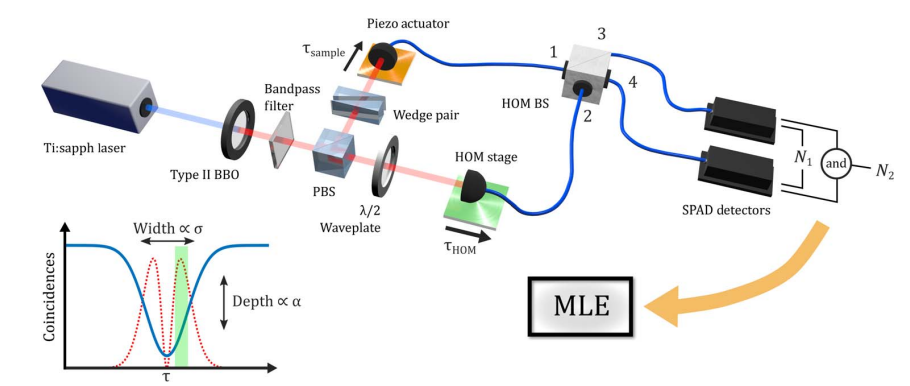 Authors: Ashley Lyons1,2, George C. Knee3, Eliot Bolduc1, Thomas Roger1, Jonathan Leach1, Erik M. Gauger1, and Daniele Faccio1,2.
Authors: Ashley Lyons1,2, George C. Knee3, Eliot Bolduc1, Thomas Roger1, Jonathan Leach1, Erik M. Gauger1, and Daniele Faccio1,2.
1School of Engineering and Physical Sciences, Heriot-Watt University, Edinburgh EH14 4AS, UK. 2School of Physics and Astronomy, University of Glasgow, Glasgow G12 8QQ, UK. 3Department of Physics, University of Warwick, Coventry CV4 7AL, UK.
Abstract
When two indistinguishable photons are each incident on separate input ports of a beamsplitter, they “bunch” deterministically, exiting via the same port as a direct consequence of their bosonic nature. This two-photon interference effect has long-held the potential for application in precision measurement of time delays, such as those induced by transparent specimens with unknown thickness profiles. However, the technique has never achieved resolutions significantly better than the few-femtosecond (micrometer) scale other than in a common-path geometry that severely limits applications. We develop the precision of Hong-Ou-Mandel interferometry toward the ultimate limits dictated by statistical estimation theory, achieving few-attosecond (or nanometer path length) scale resolutions in a dual-arm geometry, thus providing access to length scales pertinent to cell biology and monoatomic layer two-dimensional materials.
Title: Generation of multiphoton entangled quantum states by means of integrated frequency combs

Authors: Christian Reimer, Michael Kues, Piotr Roztocki, Benjamin Wetzel, Fabio Grazioso, Brent E. Little, Sai T. Chu, Tudor Johnston, Yaron Bromberg, Lucia Caspani, David J. Moss, Roberto Morandotti
Institut National de la Recherche Scientifique–Énergie Matériaux Télécommunications
(Website)
Abstract
Complex optical photon states with entanglement shared among several modes are critical to improving our fundamental understanding of quantum mechanics and have applications for quantum information processing, imaging, and microscopy. We demonstrate that optical integrated Kerr frequency combs can be used to generate several bi- and multiphoton entangled qubits, with direct applications for quantum communication and computation. Our method is compatible with contemporary fiber and quantum memory infrastructures and with chip-scale semiconductor technology, enabling compact, low-cost, and scalable implementations. The exploitation of integrated Kerr frequency combs, with their ability to generate multiple, customizable, and complex quantum states, can provide a scalable, practical, and compact platform for quantum technologies.
Title: Certifying the Presence of a Photonic Qubit by Splitting It in Two

Authors: Evan Meyer-Scott, Daniel McCloskey, Klaudia Gołos, Jeff Z. Salvail, Kent A. G. Fisher, Deny R. Hamel, Adán Cabello, Kevin J. Resch, and Thomas Jennewein
Institute for Quantum Computing and Department of Physics and Astronomy, University of Waterloo
(Website)
Abstract
We present an implementation of photonic qubit precertification that performs the delicate task of detecting the presence of a flying photon without destroying its qubit state, allowing loss-sensitive quantum cryptography and tests of nonlocality even over long distance. By splitting an incoming single photon in two via parametric down-conversion, we herald the photon’s arrival from an independent photon source while preserving its quantum information with up to
Title: On-chip generation of photon-triplet states

Authors: Stephan Krapick, Benjamin Brecht, Harald Herrmann, Viktor Quiring, and Christine Silberhorn
Applied Physics, University of Paderborn
(Website)
Abstract
Efficient sources of many-partite non-classical states are key for the advancement of quantum technologies and for the fundamental testing of quantum mechanics. We demonstrate the generation of time-correlated photon triplets at telecom wavelengths via pulsed cascaded parametric down-conversion in a monolithically integrated source. By detecting the generated states with success probabilities of (6.25 ± 1.09) × 10−11 per pump pulse at injected powers as low as 10 μW, we benchmark the efficiency of the complete system and deduce its high potential for scalability. Our source is unprecedentedly long-term stable, it overcomes interface losses intrinsically due to its monolithic architecture, and the photon-triplet states dominate uncorrelated noise significantly. These results mark crucial progress towards the proliferation of robust, scalable, synchronized and miniaturized quantum technology.
Title: Observation of genuine three-photon interference

Authors: Sascha Agne, Thomas Kauten, Jeongwan Jin, Evan Meyer-Scott, Jeff Z. Salvail, Deny R. Hamel, Kevin J. Resch, Gregor Weihs, Thomas Jennewein
Institute for Quantum Computing and Department of Physics and Astronomy, University of Waterloo
(Website)
Abstract
Multiparticle quantum interference is critical for our understanding and exploitation of quantum information, and for fundamental tests of quantum mechanics. A remarkable example of multi-partite correlations is exhibited by the Greenberger-Horne-Zeilinger (GHZ) state. In a GHZ state, three particles are correlated while no pairwise correlation is found. The manifestation of these strong correlations in an interferometric setting has been studied theoretically since 1990 but no three-photon GHZ interferometer has been realized experimentally. Here we demonstrate three-photon interference that does not originate from two-photon or single photon interference. We observe phase-dependent variation of three-photon coincidences with 90.5 ± 5.0 % visibility in a generalized Franson interferometer using energy-time entangled photon triplets. The demonstration of these strong correlations in an interferometric setting provides new avenues for multiphoton interferometry, fundamental tests of quantum mechanics and quantum information applications in higher dimensions.
